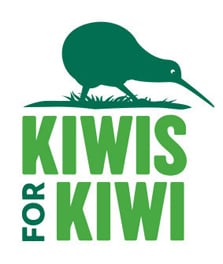Archived content: This media release was accurate on the date of publication.
Date: 28 April 2017
DOC, Kiwis for kiwi and Auckland Council are transferring kiwi pukupuku/little spotted kiwi from pest-free Kapiti Island to two safe sanctuaries in Auckland this weekend (Saturday April 29 and Sunday April 30) to help increase genetic diversity of the species.
Two groups of up to 10 kiwi are being moved to pest-free Tiritiri Matangi Island and Shakespear Open Sanctuary, off Whangaparaoa Peninsula. Tiritiri Matangi already has a breeding population of around 80 little spotted kiwi, and birds will be swapped on and off the island to mix up blood lines.
A new population of little spotted kiwi, only the third on mainland New Zealand, will be created at Shakespear Open Sanctuary with birds from Kapiti and Tiritiri Matangi.
DOC translocation project manager Angus Hulme-Moir says, “With island sanctuaries now at capacity, this new mainland population of kiwi pukapuka is critical to their survival. And it reflects the great work Auckland Council and the Shakespear Open Sanctuary Society have done to create this predator free sanctuary, providing a safe habit for these birds.”
The smallest of the five kiwi species, there are only about 1700 little spotted kiwi remaining because of introduced predators, primarily stoats, dogs and cats. Little spotted kiwi once lived throughout the North and South Islands. Today they’re found only on pest-free islands and two pest-free mainland sanctuaries - Cape Sanctuary on Cape Kidnappers in Hawke’s Bay and the Zealandia Sanctuary in Wellington.
All little spotted kiwi are descended from a small number released on Kapiti in 1912. These birds flourished and there are now about 1200 little spotted kiwi on Kapiti. “It’s now necessary to mix them up enabling birds from different locations to mate and breed,” says Angus Hulme-Muir.
Made pest free by DOC in 1996, Kapiti Island Nature Reserve is now a kōhanga kiwi site. This means the island provides little spotted kiwi to create new populations at other pest-free sites, like Shakespear Open Sanctuary.
Kiwis for kiwi director Michelle Impey says kōhanga kiwi sites play a vital role in securing the survival of kiwi.
Kiwis for kiwi is a national charity supporting community-led and Māori-led kiwi conservation projects nationwide. Kiwis for kiwi is funding the capture and release of the little spotted kiwi.
“Creating a new population of little spotted kiwi at Shakespear Open Sanctuary helps secure the future of this species. It will help us build a larger, more genetically robust population of our smallest kiwi,” says Michelle Impey.
“Saving kiwi is a group effort. It’s great to be working with the Shakespear Open Sanctuary Society, Auckland Council, DOC and Air New Zealand to bring little spotted kiwi to a safe haven on the Auckland mainland,” says Michelle Impey.
Air New Zealand is flying the Kapiti-sourced birds from Wellington to Auckland, for free on a scheduled passenger flight, as part of the airline’s conservation partnership with DOC.
Auckland Mayor Phil Goff says establishing a new little spotted kiwi population, at Shakespear Open Sanctuary, is a complicated process. But there are real rewards in terms of increasing the population size and strengthening the genetic integrity of the species.
“It’s great that Auckland can play a significant part in protecting kiwi numbers in New Zealand. This release follows on from the successful return of the North Island brown kiwi to the Hunua Ranges last month after 50 years.”
“I want to thank all the partners, staff and volunteers who have helped make this release possible.”
Contact
For media enquiries contact:
Email: media@doc.govt.nz
Michelle Impey, Kiwis for kiwi Executive Director
Phone: +64 9 307 4878
Mobile: +64 29 478 4610
Email: michelle@kiwisforkiwi.org

